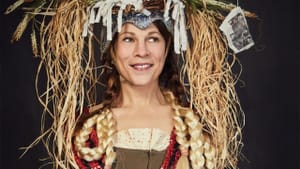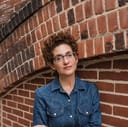Stay in the Loop
BSR publishes on a weekly schedule, with an email newsletter every Wednesday and Thursday morning. There’s no paywall, and subscribing is always free.
Best little lecture in Philly
Fabric Workshop and Museum presents Suzanne Bocanegra’s ‘Farmhouse/Whorehouse’

Suzanne Bocanegra’s well-received solo show at the Fabric Workshop and Museum, Poorly Watched Girls, explores the theatricalization of women in various forms of trouble. Bocanegra, an artist working in multiple mediums, brings a wide range of inspirations, styles, and themes to Farmhouse/Whorehouse, a performance in a format she calls an artist lecture — starring someone else.
Farmhouse/Whorehouse (which I first saw in 2017 at Brooklyn Academy of Music) is like no lecture I have ever seen. Instead, it is a mashup of aesthetic and personal autobiography with performance, slide show, music, video, and still images. Bocanegra sits on stage, inconspicuously off to the side, reading the monologue she wrote into a microphone wired to the ear of actor Lili Taylor. As Bocanegra explained, “Lili Taylor is performing tonight as me.” Like a simultaneous interpreter, Taylor recreates in real time the text dictated to her.
Eclectic, meta, and totally new
The effect is novel and strange, especially with Bocanegra present on stage. At the PAFA performance, her unamplified voice could be heard within at least the first several rows of seats, a beat or two behind Taylor’s. Taylor holds the controller for the slide show, which projects onto a screen behind her. This is pure metatheater —— but it’s also something completely new.
Like Poorly Watched Girls, Farmhouse/Whorehouse weaves together disparate-seeming topics and mediums, from a mid-twentieth-century doomsday cookbook to French painters Jean-François Millet and Édouard Manet, drawing meaningful connections that circle back to the artist’s life and work. For instance, one of Toulouse-Lautrec’s famous Moulin Rouge lithographs appears on screen early on, and Bocanegra explains that it had hung in her room when she was growing up in Texas. She chose the print because it met her childhood expectations of art: It was French and she didn’t understand it.
The Chicken Shack
The lithograph depicts Louise Weber, the dancer known as La Goulue. Women like her, working in the bars, nightclubs, and laundries of 1890s Paris, sometimes turned to prostitution to supplement their income. Young Bocanegra did not know this, nor did she know that her maternal grandparents, whose farm she loved visiting, lived across the street from the Chicken Ranch, a famed small-town brothel later immortalized in the Broadway musical The Best Little Whorehouse in Texas and the 1982 movie of the same name, starring Burt Reynolds and Dolly Parton.
When she asked her grandparents — who left school after the fourth grade and spoke German to each other — about the traffic, sometimes they told Bocanegra there was a bar or a party down the road. By the time she was an adolescent, she learned the truth and sometimes sat on the fence outside to wave a scolding finger at Chicken Ranch customers. “I can’t believe my mother let me do this,” Bocanegra says.
Mothers' experiences
The farm was important to Bocanegra and her mother in different ways. Bocanegra romanticized farm life and its connection to the hippies she idolized, while her mother regarded it as endless drudgery she eagerly escaped for office work and a modern, suburban home. Farmhouse/Whorehouse explores female experiences through this generational difference and perspective, along with Bocanegra’s description of how her own motherhood inspired her art.

“Nature takes you over” during pregnancy, Bocanegra explains through Taylor. She compares the pregnant body to a self-harvested farm: a cycle of life and death that brings reckoning with mortality. This led Bocanegra, expecting her third child, to Esther Dickey’s 1969 cookbook Passport to Survival, which models subsisting on a spartan “diet full of fear” come doomsday. As she trudged up the stairs to her fifth-floor walkup in New York, burdened with groceries and children, Bocanegra imagines herself a pioneer woman. Later, she creates a sculpture inspired by Passport to Survival, a massive collection of jars full of the four foods comprising the building blocks of its cheerless menu: powdered milk, wheat, honey, and salt.
No navel-gazing
In this way, Farmhouse/Whorehouse crafts a cohesive narrative that simultaneously is a thought-provoking, entertaining performance. In the hands of lesser artists, a piece like this could become a meaningless pastiche of navel-gazing free association. Instead, Bocanegra’s artist lecture crafts a story of art and survival, subsisting and nurturing, and gendered experience. It’s deeply moving: a series of black-and-white photos of the hands of Bocanegra’s elderly grandparents, taken for her high-school photography class, nearly brought me to tears.
Farmhouse/Whorehouse also is incredibly funny, as well as utterly true. It unearths bizarre historical relics and mines them for laughs, from the wacky beliefs of influential French philosopher Charles Fourier to a campy mashup of sci-fi and counterculture from the original Star Trek TV series. Bocanegra pokes fun at herself through anecdotes about her life and old photos of herself, including one in a scouting uniform that depicts her as a relatably nerdy kid as well as a longtime savant questing for meaning and self-expression.
Taylor was radiant in a costume designed by Bocanegra and inspired by women’s attire in the Oneida Community. She wore a white blouse under a black blazer atop a skirt-and-pants combo with boots, hair swept back from her expressive face. As a living avatar of Bocanegra and her lecture, Taylor lent voice to its story and imbued it with depth and charm.
Farmhouse/Whorehouse offers a rare and candid look inside the mind of an artist. That it is the brain of Suzanne Bocanegra, one of the most innovative and exciting makers of art today, makes it even more remarkable.
What, When, Where
Farmhouse/Whorehouse, by Suzanne Bocanegra; performed by Lili Taylor. Presented by the Fabric Workshop and Museum on February 8, 2019, at PAFA’s John and Richanda Rhoden Arts Center, 118-128 N. Broad Street, Philadelphia. (215) 561-8888 or fabricworkshopandmuseum.org.
Sign up for our newsletter
All of the week's new articles, all in one place. Sign up for the free weekly BSR newsletters, and don't miss a conversation.
 Melissa Strong
Melissa Strong